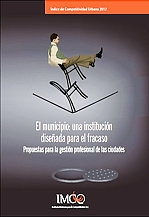In 2012, the Mexican Institute for Competitiveness (Instituto Mexicano para la Competitividad AC, IMCO) published an analysis of the competitiveness of 77 of the largest cities in Mexico, looking to see which of them offered balanced growth alongside a good quality of life for their inhabitants.
 The elements of competitiveness considered included the degree of compactness (more compact cities are more efficient and sustainable), public finances, transport, security, water management and waste management. The IMCO methodology is explained in detail in the report Índice de Competitividad Urbana 2012. In short, IMCO evaluated each of the 364 municipalities involved in the 77 cities, using 60 indicators grouped into 10 mutually-exclusive sub-indexes.
The elements of competitiveness considered included the degree of compactness (more compact cities are more efficient and sustainable), public finances, transport, security, water management and waste management. The IMCO methodology is explained in detail in the report Índice de Competitividad Urbana 2012. In short, IMCO evaluated each of the 364 municipalities involved in the 77 cities, using 60 indicators grouped into 10 mutually-exclusive sub-indexes.
Between them, these 77 cities house 63% of Mexico’s total population and account for 80% of Mexico’s GDP. 55% of Mexico’s population live in cities managed by two or more municipalities. IMCO found that public transport was adequately coordinated in only 13% of cities with two or more municipalities, while urban planning was coordinated in 35% of the multi-municipality cities.
The IMCO report concludes than most Mexican cities do NOT offer balanced growth and a decent quality of life for residents. Individual cities can be compared using this IMCO site.
The only city offering a “High” level of competitiveness was Monterrey.
Several cities offered an “Adequate” level: Mexico City, San Luis Potosí, Querétaro, Ciudad del Carmen, Saltillo, Tampico, Colima, Guadalajara, Mexicali, Monclova and Campeche.
At the other end of the spectrum, the competitiveness of several cities in Mexico was categorized as “Low”: La Piedad, Cd. Cárdenas, Rioverde, Matamoros, Tehuantepec, Tijuana, San Francisco del Rincón, Cd. Juárez, Ensenada and Poza Rica.
The lowest levels of competitiveness (“Very Low”) among the 77 cities studied were found in two cities in the state of Guerrero: Chilpancingo and Acapulco.
The report used data from 2010, so some aspects of these cities will have changed since that date. For example, the sharply increased murder rate in Monterrey since 2010 will have reduced its lead over other cities.
Certain cities have faced severe challenges of rapid growth. In recent decades, the cities that have grown most rapidly have not been the very large cities like Monterrey, but mid-sized cities. One example of a mid-sized city that has grown rapidly is Ciudad Juárez, whose area grew 497% from 1980 to 2009, while its population rose 70%. This rapid growth may have contributed to the high levels of crime experienced in the city.
IMCO concludes that Mexican cities are showing clear signs of not functioning well: chaotic expansion, heavey traffic, high levels of air pollution, poor supply and/or quality of potable water, high crime levels. These have caused cities to lose competitiveness and the capacity to attract human talent from outside, whether for business, sports or research.
The single obstacles to increased competitiveness are the lack of professional urban management, and the fact that many cities involve two or more municipalities. The laws governing municipal elections inevitably mean that administrations are short-term, with a high level of staff turnover. The impossibility of re-election means that many urban projects are overly superficial and they lack continuity from one administration to the next.
IMCO suggests that a new administrative position be created: the city manager (administrador urbano). The city manager would be a professional manager, and would ensure that the city has adequate coordination for all urban public services, even where more than one municipality is involved. This would free the municipal politicians from having to tackle the day-to-day management issues of the city and allow them more time to engage productively with the citizenry. However, for this to happen, a major institutional innovation is required.
Related posts:
Sorry, the comment form is closed at this time.